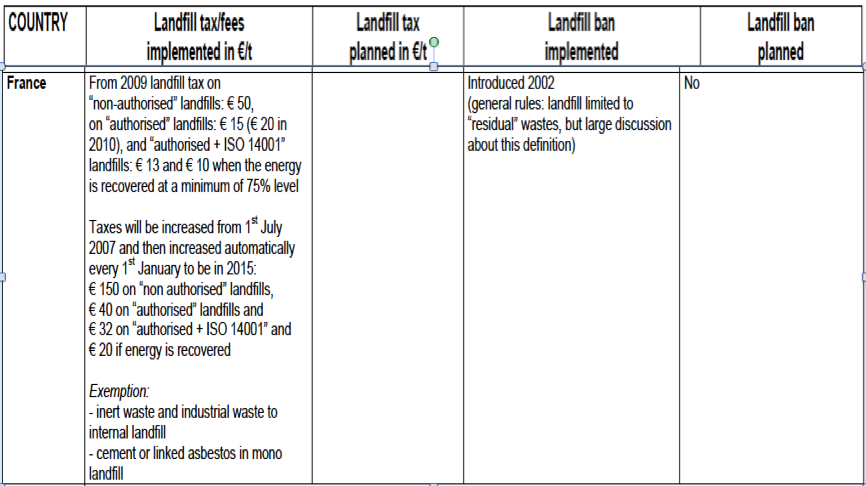EU landfill Tax: (France)
Many EU states have introduced landfill taxes. The highest rates are found in the Netherlands, (86 euros per tonne for low density waste and 14 euros per tonne for non-combustible high density waste), Flanders (62) and Denmark, (more than 50 euros per tonne), Austria and Sweden (40 euros per tonne), Wallonia, UK and Finland (more than 20 euros per tonne). Ireland, France, Czech Republic, Italy and recently Cataluna have introduced landfill taxes of 7 to 15 euros per tonne (CEWEP, 2004).
Aim:
A major reason for assessing the success of landfill taxes across EU countries is a countries ability to comply with the 1999 EU Landfill Directive (99/31/EC).
It has set targets for existing sites to:
l Reduce biodegradable municipal waste sent to landfill by 75%, 50% and 35% of that produced in 1995 by 2010, 2013 and 2020 respectively.
l Ban landfill of hazardous and non-hazardous wastes together from July 2004
l Ban liquid waste, and certain hazardous wastes by 2001
l Ban landfill of whole tyres by 2003 and shredded tyres by 2006.
France Aim:
The direct aim of the tax was to have a significant incentive effect through the “price signal” passed over to landfill users. It was implemented to streamline French waste management through increasing waste recovery, and providing for full cost recovery of waste management. It is one of the policy instruments of the national strategy to restrict disposal to landfill to final waste only that cannot be recovered by any other treatment by 2002. An indirect aim is to finance the Modernisation Fund for Waste Management (MFWM), created in 1993 and run by ADEME.
Tax Rate Detail:
Revenue:
Basically the revenue will be collected from every householder.
All persons or legal entities operating a household and assimilated waste landfill site – whether they have been granted authorization or not – are liable to pay the tax.
But is it revenue neutral?
France Landfill tax is not revenue neutral.
The landfill tax payments received by ADEME were up to 1999 fed into the MFWM, instituted by a decree of March 1993 (number 93-744) and administered by ADEME. —Economic Instruments.com
Coverage is very clear but far away from perfect:
One of the issues about France Landfill tax is definition about “waste”. Fortunately, France waste definition has been improved after authorities acknowledging the “grey area” in waste, and the lack of data in this respect.
The type of the waste is classified into four main types:
l Household Waste (HW)
l Other Municipal Solid Waste (MSW) waste
l Mixed Industrial Waste (MIW) inert and harmless industrial waste e.g. paper, board, metals, wood and plastics from industry, administrations, retail, services which do not require any special treatment (disposed on Class II & III landfill sites). Other type of waste (not municipal)
l Other type of waste (not municipal), mixed industrial waste (MIWS) collected separately amounts
Within 150 million tons of wasted been taxed, MIWS account for 100 Million tons. However, the disposal pattern is not well known as these do not follow the municipal Waste Path. (and so are not in the control of local authorities). It is estimated that 90% of MIWA is disposed in owner-operated landfill sites. Only 8% of total MIW is disposed of in public landfill sites.
But how to deal with the landfill waste, which is harmful to environmental, is unknown. Moreover, MIWS was not control by the municipal.
l Appropriateness of land fills tax (France)
Because there is lack of data, we are can observe the appropriateness of land fills tax from the performance of this tax.
ADEME estimated that 59% of total household, municipal and mixed industrial was still being landfilled in 1997 against 61% in 1989 and 63% in 1993 (Ecotec, 2001). Although municipalities typically have fixed-term contracts with landfill operators, some have switched to incineration and sorting / recycling since 1997. In 2005, new targets were set by the French Government on the amount of household waste going to landfills or incinerators. The aim is to reduce from 290kg per head in 2005, to 250kg by 2010 and to 200kg by 2015 (ENDS, 2005). The new landfill campaign intended to feature increased information available to the public as well as the fiscal measures. The tariff for electricity produced from waste-derived biogas is to be increased by 50%. The national tax on polluting activities (TGAP) is to be doubled for waste dumped in uncontrolled landfill sites (ENDS, 2005). It is hoped that this increase in TGAP will speed up the closing of all uncontrolled sites at least within the target of 18 months. French local authorities will be given powers to levy their own taxes on waste sent to dumps and incinerators. A national plan for the development of composting is hoped to be in place by mid 2006 (ENDS, 2005).
Even though the French Landfill tax is relatively low and landfilling is often still the cheapest option, the mixture of the landfill tax with regulations (including a ban on the landfilling of untreated waste in 2002) has meant that the amount of waste going to landfill did not increase and the patterns that existed in the 1990s continued into the early 2000s (Bartelings et al., 2005). Over the years 1993 to 1997, the share of landfilling in waste disposal in France decreased from 64% to 59%. Since 1997, some municipalities have switched to incineration and sorting/recycling, even though they probably have fixed term contracts with landfill operators (Bartelings et al., 2005).
References
ADEME, 1998, Taxe parafiscale sur la pollution atmosphérique – Rapport d’activité 1997.
Bartelings, H., Beukering, P. van, Kuik, O., Linderhof, V., & Oosterhuis, F., 2005. Effectiveness of landfill taxation. IVM report R-05/05, Institute for Environmental Studies, Vrije Universiteit, Amsterdam.
Ecotec, 2001. Study on Environmental Taxes and Charges in the EU. http://europa.eu.int/comm/environment/enveco/taxation/environmental_taxes.htm
ENDS, 2004, Environmental Daily 13/2/2004.
ENDS, 2005, Environmental Daily Issue No. 1946, September 2005.

